Winchester College
Winchester College is an independent boarding school for boys in the British public school tradition, situated in Winchester, Hampshire. It has existed in its present location for over 600 years. It is the oldest of the original nine English public schools defined by the Clarendon Commission, seven of which were regulated by the Public Schools Act 1868.
| Winchester College | |
|---|---|
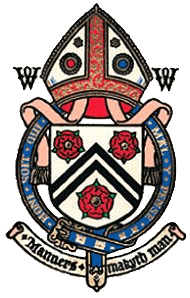 | |
 | |
| Address | |
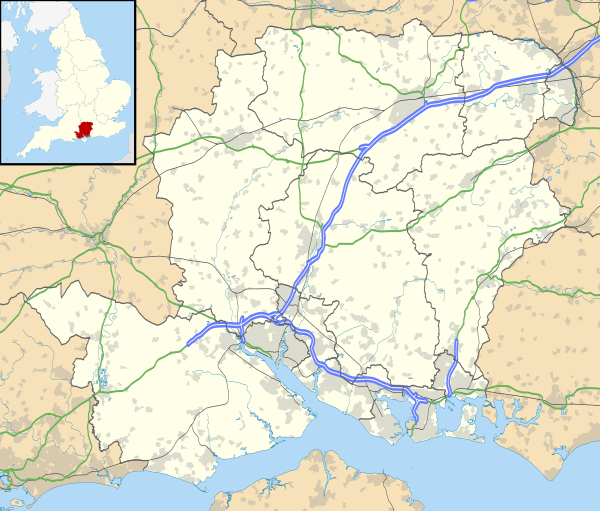 Winchester College 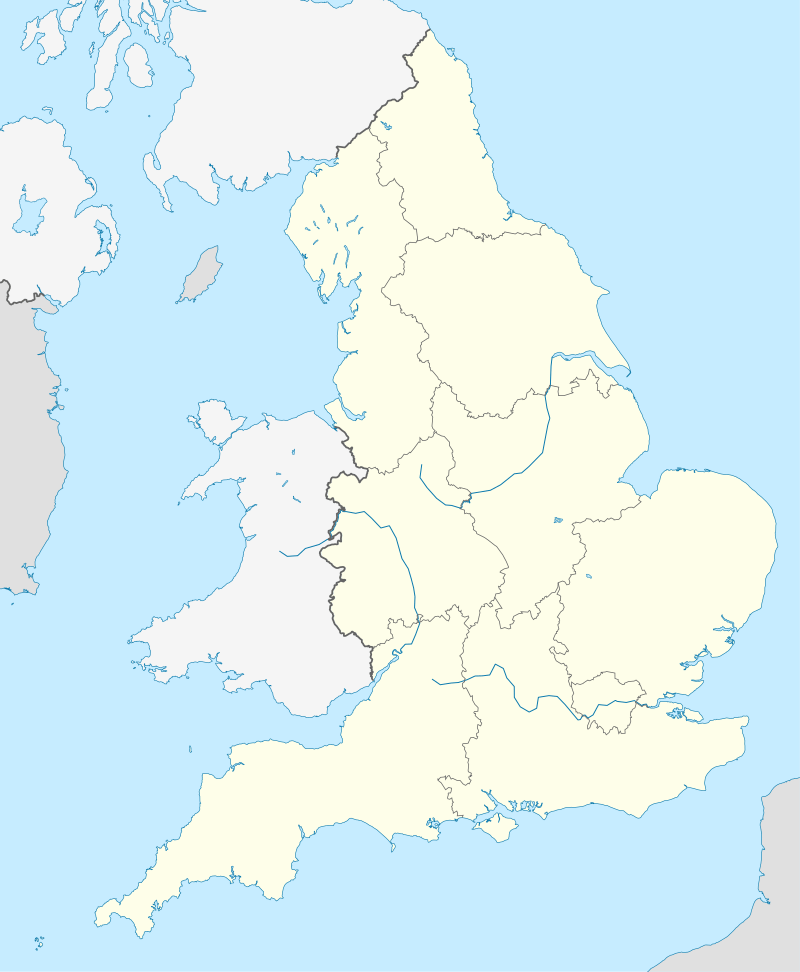 Winchester College 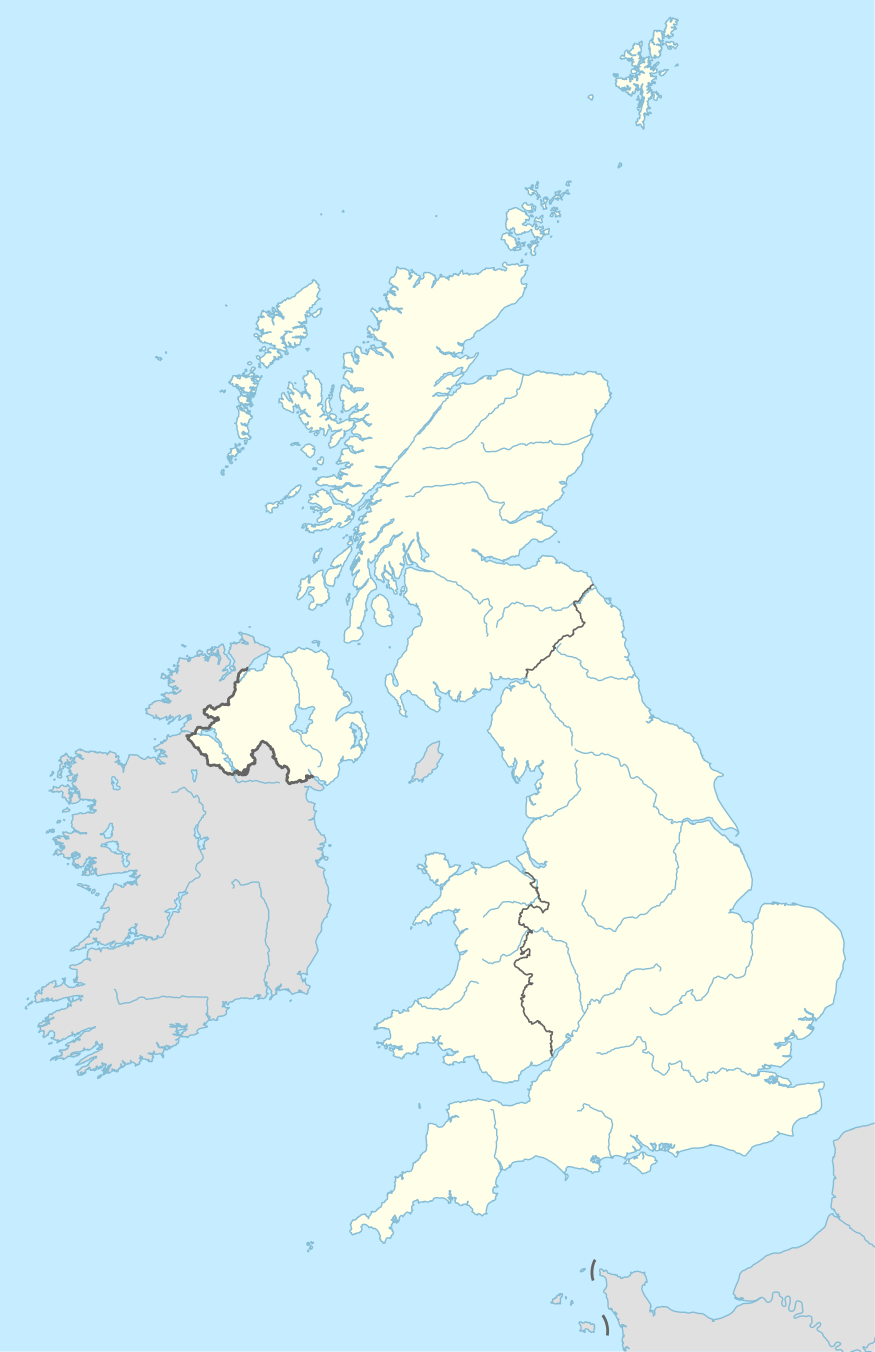 Winchester College | |
College Street , , SO23 9NA England | |
| Coordinates | 51.058°N 1.313°W |
| Information | |
| Type | Public school Independent boarding school |
| Motto | Manners makyth man |
| Religious affiliation(s) | Church of England |
| Established | 1382 |
| Founder | William of Wykeham |
| Department for Education URN | 116532 Tables |
| Warden | Richard Stagg |
| Headmaster | Timothy Hands |
| Staff | ~200 |
| Gender | Male |
| Age | 13 to 18 |
| Enrolment | ~673 |
| Houses | 11 (10 Commoner Houses plus college)
College A. Chernocke House (Furley’s) B. Moberly’s (Toye’s) C. Du Boulay’s (Cook’s) D. Fearon’s (Kenny’s) E. Morshead’s (Freddie’s) F. Hawkins’ (Chawker’s) G. Sergeant’s (Phil’s) H. Bramston’s (Trant’s) I. Turner’s (Hopper’s) K. Kingsgate House (Beloe’s) |
| Colour(s) | Blue, brown & red |
| Publication | The Wykehamist, Quelle, The Spirit Lamp, The Trusty Servant |
| Former pupils | Old Wykehamists |
| School song | Dulce Domum |
| Website | www |

| |
Official name
According to its 1382 charter and final statutes (1400), the school is called in Latin Collegium Sanctae Mariae prope Wintoniam, or Collegium Beatae Mariae Wintoniensis prope Winton, which translates as St Mary's College, near Winchester, or The College of the Blessed Mary of Winchester, near Winchester.[1][2]:9,45–47 It is sometimes referred to by pupils, former pupils and others as "Win: Coll:", and is more widely known as just "Winchester".
Wykehamists
Current pupils of Winchester College are known as Wykehamists, in memory of the school's founder, William of Wykeham; former pupils are known as Old Wykehamists,[3] or amongst themselves as Old Woks.[4]
History
Winchester College was founded in 1382 by William of Wykeham, Bishop of Winchester and Chancellor to both Edward III and Richard II, and the first 70 poor scholars entered the school in 1394.[5] In the early 15th century the specific requirement was that scholars come from families where the income was less than five marks sterling (£3 6s 8d) per annum; in comparison, the contemporary reasonable living for a yeoman was £5 per annum.[6] It was founded in conjunction with New College, Oxford, for which it was designed to act as a feeder: the buildings of both colleges were designed by master mason William Wynford. This double foundation was the model for Eton College and King's College, Cambridge, some 50 years later, and for Westminster School, Christ Church, Oxford, and Trinity College, Cambridge, in Tudor times.
In addition to the 70 scholars and 16 "Quiristers" (choristers), the statutes provided for ten "noble Commoners". These Commoners ("Commoners in Collegio") were paying guests of the Headmaster or Second Master in his official apartments in College. Other paying pupils ("Commoners extra Collegium"), either guests of one of the Masters in his private house or living in lodgings in town, grew in numbers till the late 18th century, when they were all required to live in "Old Commoners" and town boarding was banned. In the 19th century this was replaced by "New Commoners", and the numbers fluctuated between 70 and 130. The new building was compared unfavourably to a workhouse, and as it was built over an underground stream, epidemics of typhus and malaria were common.
In the late 1850s four boarding houses were planned (but only three built: those referred to as A, B and C), to be headed by housemasters: the plan, since dropped, was to increase the number of scholars to 100 so that there would be "College", "Commoners" and "Houses" consisting of 100 pupils each. In the 1860s "New Commoners" was closed and converted to classrooms, and its members were divided among four further boarding houses (D, E, G and H, collectively known as "Commoner Block"). At the same time two more houses (F and I) were acquired and added to the "Houses" category (more formally known as Old Tutors' Houses or O.T.H.); a tenth (K) was acquired in 1905 and allotted to "Commoners". The distinction between "Commoners" and "Houses" is now of purely sporting significance, such as for Winchester College Football, and "a Commoner" now means any pupil who is not a scholar. There are therefore now ten houses in addition to College, which continues to occupy the original 14th-century buildings, and the total number of pupils is almost 700. From the late 1970s there has been a continual process of extension to and upgrading of College Chambers.
College
The seventy Scholars live in the original buildings, known as College; an individual scholar is known as a "Collegeman". College is not usually referred to as a house: hence the terms 'housemaster of College' and 'College house' are not used. The schoolmaster in charge of College is now known as the Master in College, although these duties formerly belonged to the Second Master. The same title, Master in College, is also used by the housemaster of the King's Scholars at Eton. The Collegemen wear black gowns, following the founding traditions of the school.
Within the school, 'College', without 'the', means both the body of scholars and their buildings; 'Winchester College' and 'the college' refer to the school as a whole.
The scholars, called 'Collegemen', enjoy certain privileges compared to the Commoners, such as having open fires and being notionally allowed to walk across Meads, the field outside School.
Boarding houses
| Official Name | Informal Name | House Letter |
|---|---|---|
| Chernocke House | Furley's | A |
| Moberly's | Toye's | B |
| Du Boulay's | Cook's | C |
| Fearon's | Kenny's | D |
| Morshead's | Freddie's | E |
| Hawkins' | Chawker's | F |
| Sergeant's | Phil's | G |
| Bramston's | Trant's | H |
| Turner's | Hopper's | I |
| Kingsgate House | Beloe's | K |
Every pupil at Winchester, apart from the Scholars, lives in a boarding house, chosen or allocated when applying to Winchester. It is here that he studies, eats and sleeps. Each house is presided over by a housemaster (who takes on the role in addition to teaching duties) and a number of house tutors (usually five or six – Mon to Fri). Houses compete in school competitions, mostly in sporting competitions. Each house has an official name, usually based on the family name of the first housemaster, which is used mainly as a postal address. Each house also has an informal name, which is more frequently used in speech, usually based on the name or nickname of an early housemaster. Each house also has a letter assigned to it, in the order of their founding, to act as an abbreviation, especially on laundry tags. A member of a house is described by the informal name of the house with "-ite" suffixed, as "a Furleyite", "a Toyeite", "a Cookite" and so on. The houses have been ordered by their year of founding. College does not have an informal name, although the abbreviation Coll is sometimes used, especially on written work. It also has a letter assigned to it, X, but it is considered bad form to use this except as a laundry mark or in lists of sporting fixtures. [lower-alpha 1]
Each house also had a set of house colours, which adorned the ribbon worn around boys' "strats" (straw hats). New Men (New boys) sported a strat with a 3-inch strat-band and if they became a Three-Year Men (3 Years at the school), they could sport a strat with a thinner 1 inch strat band. Up to the mid-1970s, Three-Year Men were allowed to wear a strat made of speckled straw. The wearing of strats ceased to be compulsory for Commoners in 1984 – Collegemen had stopped wearing them years earlier. They can however still occasionally be seen being sported on Winchester Day. House colours are now used on socks and "pussies", scarves awarded for exceptional contribution to the house or society.
Admission
Winchester has its own entrance examination, and does not use Common Entrance like other major public schools. Those wishing to enter a Commoner House make their arrangements with the relevant housemaster some two years before sitting the exam, usually sitting a test set by the housemaster and an interview. Those applying to College do not take the normal entrance examination but instead sit a separate, harder, exam called "Election": successful candidates may obtain, according to their performance, a scholarship, an exhibition or a Headmaster's nomination to join a Commoner House (without remission of fees).
Admission to College is on academic merit, as measured in the Election examination, regardless of financial means, though the original statutes specified that the foundation existed for poor scholars and required entrants to take an oath that their net income did not exceed a figure chosen as the average income for the time. Scholars enjoyed a remission of fees, amounting for much of the 20th century to two-thirds of the total. This remission has since been progressively reduced, and is due to be abolished altogether.[7] The intention is to maintain the academic and institutional distinction between Scholars and Commoners, while using the money saved to fund bursaries for those pupils least able to pay, Scholars and Commoners alike.
Pastoral structure
Prefectorial system
College
Traditionally there were always 18 prefects in College, though since the mid-20th century there have been fewer, 10 to 14 being typical. Of these, five (later increased to six) hold salaried offices. Historically, these were as follows, in descending order of seniority:
- Aulae Praefectus (Aul: Prae:, Prefect of Hall), the head boy of the school. ("Hall", in this connection, is not restricted to the dining hall but means the College as a whole, as in the phrases "Trinity Hall, Cambridge" and "halls of residence" at Harvard University.) He acts jointly with the Sen: Co: Prae: (see below).
- Bibliothecae Praefectus (Bib: Prae:, Prefect of Library), until recently in charge of Moberly Library (the school academic library); this function has now been taken over by a full-time librarian.
- Scholae Praefectus (Schol: Prae:, Prefect of School), in charge of bookings of the old School building and miscellaneous other functions.
- two Capellae Praefecti (Cap: Prae:, Prefects of Chapel): functions obvious. Formerly they took turns to officiate; until recently practice has been to differentiate between the "Sen: Cap: Prae:" and the "Jun: Cap: Prae:". Nowadays there is only one Cap: Prae:
The post of Jun: Cap: Prae: (junior chapel prefect) has recently been abolished and has been replaced by Ollae Praefectus (Oll: Prae:), which literally translates as "prefect of tub". (This is the revival of an ancient office, which was suppressed in the 19th century when the office of Bib: Prae: was created. The duties were to do with catering, especially the disposal of uneaten food from College lunch, which was collected in a special wooden vat and given to the poor. This vat or tub is still on display in College Hall.)
Each Officer, in addition to his specialized duties, has charge of a College Chamber (day-room). Thus when IVth Chamber was reopened, increasing the number of chambers to six, a sixth Officer was created, the Coll: Lib: Prae:, in charge of Upper Coll: Lib: (the fiction library available to Collegemen). The post had previously existed informally, but the holder used not to rank as an Officer.[lower-alpha 2]
Formerly, there were one or two (originally five) further prefects "in full power", invariably, though improperly, known as Co: Praes. Officers and Co: Praes had authority throughout the school; the remaining prefects had authority only in College. Nowadays, while there are still six officers, they have little to do with the running of the school and are mainly responsible for their respective chambers, and there are no other College Co: Praes. In practice, only the Prefect of Hall has significant duties outside College.
The present practice is for all fifth-years in College to be prefects. Each officer nominates a prefect from those members of his year who are not officers to act as his deputy within his chamber; any prefects left over are sometimes known as "Jemimas" (reason unknown). The seven senior inferiors (non-prefects) in College are known as Custodes Candelarum (tollykeepers), but this is a purely nominal dignity. The next senior person in a chamber after the prefects and tollykeepers was once known as the in loco, and kept the accounts for Chamber Tea.
Commoner Houses
Outside College there is a Sen: Co: Prae: (Senior Commoner Prefect), who acts as joint Head Boy with the Prefect of Hall. There are then a number of Co: Praes (Commensalibus Praefecti, Commoner Prefects) with authority over all Commoners: traditionally, no Commoner has authority over any Collegeman. Nowadays, there is generally only one Co: Prae: per house, who acts as the senior house prefect. However, in the house where the "Sen: Co: Prae:" is resident, there is sometimes another "Co: Prae:" who has been nominated as the Head of House. In addition, each house has a number of House Prefects, with authority only in that house. The Co: Praes (heads of houses) meet weekly together with the Prefect of Hall and Head Master to discuss the running of the school.
Academic structure
Until the 1860s the predominant subject of instruction was classics, and there was one main schoolroom used as both the classroom and the place of preparation, under extremely noisy conditions: there were adjacent rooms used for French and mathematics. Under the headmastership of George Ridding proper classrooms were built, and pupils had the option of joining "Parallel Div" for the study of history and modern languages. Later still a "Sen: Science Div" was added. Science teaching at Winchester had a high reputation: one of the early science masters duplicated the experiments of Hertz about radio waves, the equipment for which is still preserved at Science School.
For much of the 20th century the senior forms were divided among three "ladders": the A ladder for classics, the B ladder for history and modern languages and the C ladder for mathematics and science. There was also a vertical division, in descending order, into Sixth Book (equivalent to the sixth form at other schools), Senior Part, Middle Part and Junior Part: depending on ability, new boys were placed in either Junior or Middle Part.
The school now offers a wide range of subjects, and no longer has a system of ladders. In 2008 it abandoned A-level as its matriculation credential and adopted the Cambridge Pre-U on the grounds that this will strengthen the quality of the school's intellectual life. In addition to normal lessons, all boys throughout the school are required to attend a class called Division (Div for short) which focuses on parts of history, literature, and politics that do not lead to external examinations; its purpose is to ensure a broad education that does not focus solely on examinations.
Results and universities
At Pre-U, 49.3% of grades achieved were D1 or D2, and 86.4% of grades achieved were D1-M1 in 2018. 68.4% of GCSEs were graded A* or equivalent (9 or 8), in comparison to 62.5% in 2017; 92.1% were graded A*/A or equivalent (9,8 or 7), in comparison to 90.5% in 2017. There were 36 Oxbridge offers; 18 at Oxford and 18 at Cambridge.[8]
Pre U summary: last five years[9]
| YEAR | % D1/D2 | % D1/D2/D3 | % D1 to M2 |
|---|---|---|---|
| 2018 | 49.3 | 74.5 | 92.3 |
| 2017 | 47.9 | 71.3 | 92.3 |
| 2016 | 49.9 | 75.4 | 92.8 |
| 2015 | 47.4 | 75.2 | 92.8 |
| 2014 | 51.1 | 79.5 | 94.7 |
A-level equivalents: D1=A*+ D2=A* D3=A M1=A/B M2=B/C M3=C P1=C/D P2=D P3=E U=U
Buildings
Chapel
 Winchester College chapel
Winchester College chapel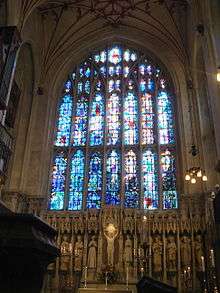 East window
East window Chapel ceiling
Chapel ceiling- North side (before restoration)
- North side (after restoration)
Situated on the south side of Chamber Court, the chapel is part of the original college buildings and retains its original wooden fan-vaulted ceiling. Built to accommodate just over 100 people, it long ago became too small to accommodate the whole school (currently 690 boys). Additional seating installed in the re-ordering and extension carried out by the Victorian architect Butterfield allows the chapel to seat 320 people. On Sundays half the houses worship in Chapel, while the other half worship (at the same time) in St Michael's Church (known as Michla), a redundant parish church central among the boarding houses, which the College took over in the last century. Weekly choral services are sung by the Choir in Chapel on Tuesdays and by the Quiristers on Thursday and Saturday evenings in Fromond's Chantry, which is in the middle of the cloisters. Roman Catholic boys attend mass every Sunday morning in St Michael's Church.
A striking feature of the chapel is its stained glass. The East window depicts the stem of Jesse. Down the chapel's north and south sides is a collection of saints. Little of the original medieval glass, designed by Thomas Glazier, survives. A firm of glaziers in Shrewsbury was tasked with cleaning the glass in the 1820s. At that time there was no known process for cleaning the badly deteriorated glass and so it was copied, while most of the original glass was scattered or destroyed. Some pieces have been recovered. The south west corner holds the largest piece, bought and donated by Kenneth Clark. Five other figures bequeathed by Otto von Kienbusch and two more donated by Coleorton Church, Leicestershire were placed in Fromond's Chantry in 1978.
Until Victorian times the chapel was divided into a chapel and ante-chapel, and had decorative panelling. This panelling was recovered by the school in the 1960s and used in the building of New Hall, the school concert hall, the design of which was specifically planned so as to house it.
The Chapel Choir sings regular services in the Chapel, as well as other venues. This consists of sixteen Quiristers (who attend The Pilgrims' School) and a similar number of senior boys and a few dons (masters). A non-quirister choir sings the services in St Michael's Church.
The exterior of the Chapel and the Hall underwent extensive restoration of the stonework at the end of the twentieth century.
War Cloister

Situated to the west of Meads, this cloister serves as a memorial to the Wykehamist dead of the two World Wars. It was designed by Sir Herbert Baker and dedicated in 1924 and again in 1948.
A bronze bust of Old Boy Air Chief Marshal Lord Dowding sits on the west side of the cloister.
War Cloister occupies a strategic position on Kingsgate Street (accessed via "South Africa Gate", which commemorates the Wykehamist dead of the 1899–1902 Boer War), so that most Commoners go through it on their way to and from class. (Furleyites, Beloeites and Freddyites tend to walk past the Common Room and the Queen Elizabeth II theatre, then along Meads Path.)
Another older war memorial in the school is the entry chamber to Chapel, known as "Crimea" after the Crimean War of 1853–56, and bearing the names of Wykehamists who died at the siege of Sebastopol.
Traditions
Notions
A notion is a manner or tradition peculiar to Winchester College. The word notion is also used for words and phrases used only in the school. An example is "toytime", meaning prep or homework, from the "toys" or individual cubicles that formerly served as pupils' workspace in the communal chamber or "mugging hall", from "mug" meaning to work.[10]
Sport
Winchester College has its own game, Winchester College football (also known as 'Win: Co: Fo:' or, more recently, 'Winkies'), played only at Winchester. It is played in Common Time (the spring term), the main game in Short Half (the autumn term) being Association football. In Cloister Time (the summer term) the main sports are tennis and cricket.
Winchester Football could be considered a cross between football and rugby, though this analogy shouldn't be taken too far since there are significant differences. For example, the ball can only be carried, like in rugby, if caught full toss. Furthermore, no football-type "dribbling" is allowed since the player may not touch the ball more than once at a time. Neither can the ball be passed to a team-mate, except by back-heeling to a teammate behind. Furthermore, a player who finds himself upfield must return to the point at which his teammate last kicked the ball before being able to join in the game again, unless in the interim an opposite player has touched the ball. The current form of the game can be played by teams of 6, 9, 10, 11, or 15. There are also rugby-type scrums known as "hots", which feature 8 forwards in the 15-player version and 3 in the 6-player version of the game. The objective is to kick the ball over the opponent's goal line ("worms"). The field ("canvas") is 73 m (240 ft) long and 24.5 m (60 ft) wide. It is delimited lengthwise by canvas netting and by posts threaded with a heavy rope that run parallel 1 metre inside the netting, and 1 metre above the ground.
There is also a distinctive Winchester version of Fives, resembling Rugby Fives but with a buttress on the court. Winchester currently has 4 active Winchester fives courts. It has been claimed that Rugby Fives and Winchester Fives are both forms of "Wessex Fives", and that Thomas Arnold took with him the game of Wessex Fives he played as a boy at what is now Warminster School when he became the Headmaster of Rugby School.
In 1647, a Latin poem by Robert Matthew contains a probable reference to cricket being played by pupils of Winchester College on nearby St Catherine's Hill. If authentic, this is the earliest known mention of cricket in the county of Hampshire.[11]
At one time Winchester was one of the Lord's schools, competing in a trilateral cricket tournament with Eton and Harrow; and for this reason the first cricket eleven is still known as "Lords" (with or without the apostrophe). Since 1855 Winchester has not taken part in this, instead playing Eton alternately at the two schools. Eton Match, when played at Winchester, was until recently the major event attended by Old Wykehamists and the main showcase for the school and its activities, but now most of the non-cricket-related functions have been moved to "Wykeham Day" in the autumn. Eton Match itself has now been replaced by "Winchester Day", featuring a match between Wykehamists and Old Wykehamists. The cricket ground has held one first-class match, held in 1875 when Hampshire played Kent.[12]
Rackets is also played. Should the same person be Captain of Lord's and Captain of Rackets, he is known as "Lord of Lords and Prince of Princes", in allusion to Prince's Club in London.
The "Winchester Ice Club" was formed in 1904 by R. L. G. Irving; amongst its first members was George Mallory, who later died on Mount Everest.
Combined Cadet Force
Pupils of the school in their second year are currently required to serve in the College's Combined Cadet Force.[13]
The organisation was founded in 1860 as "The Winchester College Rifle Volunteer Corps" by various boys in their top year as a result of the perceived threat of Napoleon III after the Orsini plot, and remained entirely autonomous until it was taken over by the Second Master in 1868. It was enrolled as a Cadet Corps in the 1st Hants Volunteer Battalion. In 1908, the Officer Training Corps was established, and by 1914, through the request of the War Office that Senior Cadets be given appropriate training for the war effort, almost every student became involved in the Corps, though it was never explicitly compulsory. In the Second World War, it was renamed as "The Junior Training Corps", though its function was still to prepare boys for Officer responsibilities. Montgomery remarked on inspecting the Corps in 1946 that there was "latent leadership in all ranks". In 1948, the "Junior Training Corps" became known as the "Combined Cadet Force" (CCF) which incorporated RAF and RN sections. In 1963, "Alternative Service Activities" were introduced for boys who did not want to join the CCF. Pupils were made eligible to opt out of the CCF at the end of their second year after starting at the beginning of the year: this is still the school's policy.[14] In 2010, Winchester's Combined Cadet Force received the Queen's Colours, a regimental decoration.[15]
School song Domum
The school song is "Dulce Domum", which is sung on the approach of and at the break-up of the school for the summer holidays, and on other occasions when a school song is normally sung. It is also sung at Abingdon School, Twyford School and Stamford School under similar circumstances, and was popular among 19th-century English public schoolboys. For example, it is mentioned in the early chapters of Tom Brown's School Days. Paradoxically, although the subject of the song is the joy of breaking from the school grind and returning home for the holidays, it is often taken as symbolising the idyllic, nostalgic view of English public school life in the 19th century. It should not be confused with another song of the same name, but with completely different tune and lyrics, written by Robert S. Ambrose.
The traditional tune[16][17] was composed by John Reading. A new tune, by Malcolm Archer, was officially adopted by the school in about 2007.[18]
According to legend, the text was composed in the 17th century by a pupil who was confined for misconduct during the Whitsun holidays.[19] (In one account, he was tied to a pillar.) It is said that he carved the words on the bark of a tree, which was thereafter called "Domum Tree", and cast himself into Logie (the river running through the school grounds).[20] There is still a "Domum Cottage" in that area.
The chorus of the song (in Latin, with English translation) runs:
Domum, domum, dulce domum!
Domum, domum, dulce domum;
Dulce, dulce dulce domum!
Dulce domum resonemus.
Home, home, joyous home! (or: Homeward, homeward, joyously homeward!)
Home, home, joyous home!
Joyous, joyous, joyous home!
Hurrah for joyous home!
The author of the text apparently wrongly treated domum as a neuter noun.[21] However, domum could also be the accusative of domus, meaning "homeward", making dulce an adverb, so the phrase dulce domum would mean "sweetly homewards" rather than the apparent "sweet home", though the usual adverb meaning "sweetly" is "dulciter".
A "Domum Dinner" is held at the end of the summer term for leavers. It was formerly restricted to those former scholars of Winchester who were also scholars of New College, and distinguished guests. Until the reforms of the 19th century, there were three successive Election Dinners held during Election Week, culminating in a Domum Ball. Originally these festivities occurred around Whitsun, as suggested by references to early summer such as "See the year, the meadow, smiling" and "Now the swallow seeks her dwelling" in the song.[16] When Election Week was moved to the end of the summer term (June or July) the Domum celebrations were moved with it, though the Whitsun references remained.
The Trusty Servant
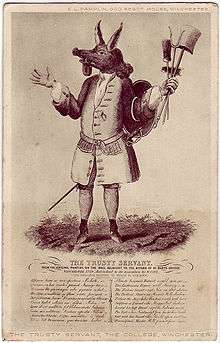
A 1579 wall-painting of The Trusty Servant by the poet John Hoskins hangs outside the college kitchen. It depicts a mythical creature with the body of a man, the head of a pig, its snout closed with a padlock (to keep secrets), the ears of an ass (to hear his master calling), the feet of a stag (for swiftness), and holding working tools in his left hand.[22] It is accompanied by allegorical verses on the virtues that pupils of the college were supposed to have. The college arms are shown in the background.[23][24]
"The Trusty Servant" is also the name of a magazine published for Old Wykehamists.
Winchester quotations
Manners makyth man
– William of Wykeham Motto of Winchester College and New College, Oxford
Broad of Church and broad of mind,
Broad before and broad behind,
A keen ecclesiologist,
A rather dirty Wykehamist.
– John Betjeman "The Wykehamist"
Leader in London's preservation lists
And least Wykehamical of Wykehamists{:}
Clan chief of Paddington's distinguished set,
Pray go on living to a hundred yet!
– John Betjeman "For Patrick" (about Patrick Balfour, 3rd Baron Kinross)
You can always tell a Wykehamist, but you can never tell him much
– Anon.
These Wykehamists have the kind of mind that likes to relax by composing Alcaics on the moving parts of their toy trains.
– Evelyn Waugh
Would you doubt the word of a Wykehamist?
– Edward Grey, 1st Viscount Grey of Fallodon
O, Eternal God, the Life and the Resurrection of all them that believe in Thee, always to be praised as well for the Dead as for those that be Alive, we give Thee most hearty Thanks for our Founder, William of Wykeham; and all other our Benefactors, by whose Benefits we are here brought up to Godliness and the studies of good Learning; beseeching Thee that we, well using all these Thy Blessings to the Praise and Honour of Thy Holy Name, may at length be brought to the Immortal Glory of the Resurrection, through Jesus Christ our Lord. Amen.
– "Thanksgiving for the Founder" as at present used on commemoration days
Headmasters
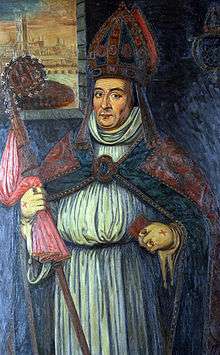
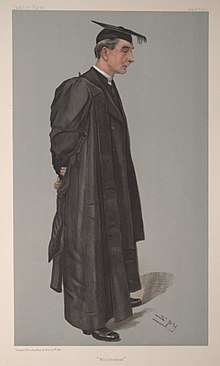
- 1373 Richard Herton
- 1388 John Melton
- 1394 Thomas Romsey
- 1407 John Pole
- 1414 Thomas Romsey
- 1418 Richard Darcy
- 1424 Thomas Alwyn
- 1430 William Waynflete
- 1441 Thomas Alwyn
- 1444 William Yve
- 1454 John Barnard
- 1459 John Grene
- 1465 Clement Smyth
- 1467 Richard Dene
- 1484 John Rede
- 1490 Robert Festham
- 1495 William Horman
- 1501 John Farlyngton
- 1507 Edward More
- 1515 Thomas Erlisman
- 1525 John Twychener
- 1531 Richard Twychener
- 1535 John White
- 1542 Thomas Bayly
- 1547 William Everard
- 1553 Thomas Hyde
- 1561 Christopher Johnson
- 1572 Thomas Bilson
- 1579 Hugh Lloyd
- 1588 John Harmar
- 1596 Benjamin Heyden
- 1602 Nicholas Love
- 1613 Hugh Robinson
- 1627 Edward Stanley
- 1642 John Pottinger
- 1653 William Burt
- 1658 Henry Beeston
- 1679 William Harris
- 1700 Thomas Cheyney
- 1724 John Burton
- 1766 Joseph Warton
- 1793 William Stanley Goddard
- 1810 Henry Dyson Gabell
- 1824 David Williams
- 1836 George Moberly
- 1867 George Ridding
- 1884 William Andrewes Fearon
- 1901 Hubert Murray Burge
- 1911 Montague John Rendall
- 1924 Alwyn Terrell Petre Williams
- 1934 Spencer Leeson
- 1946 Walter Fraser Oakeshott
- 1954 Henry Desmond Pritchard Lee
- 1968 John Leonard Thorn
- 1985 James Paley Sabben-Clare
- 2000 Edward Nicholas Tate
- 2003 Thomas Richard Cookson
- 2005 Ralph Douglas Townsend
- 2016 Timothy Roderick Hands[25]
Former pupils
Controversy
Bash camps
The college knew in 1982 of allegations of sadomasochistic abuse of boys and young men attending summer camps run by the Iwerne Trust in the 1970s, "to ensure that future members of the establishment were committed Christians" These were known as “Bash camps” after the nickname of their founder, E. J. H. Nash. Neither the college or the Trust reported these bare-buttocks beatings to the police.[26] The perpetrator, John Smyth QC, now deceased was warned off and moved to Zimbabwe and then South Africa where abuse continued. Hampshire police are investigating and the college is cooperating.[27]
Price-fixing
In 2005, Winchester College was one of fifty of the country's leading independent schools which were found guilty of running an unlawful price-fixing cartel by the Office of Fair Trading ("OFT").[28] All of the schools involved agreed to make penalty payments totalling three million pounds into a trust designed to benefit pupils who attended the schools during the period in which fee information was shared.[29] The OFT offered both Winchester College and Eton a fifty percent reduction in their penalties in return for their full cooperation with the investigation.[30] However, Jean Scott, the head of the Independent Schools Council, said that independent schools had always been exempt from anti-cartel rules applied to business, were following a long-established procedure in sharing the information with each other, and that they were unaware of the change to the law (on which they had not been consulted). She wrote to John Vickers, the OFT director-general, saying, "They are not a group of businessmen meeting behind closed doors to fix the price of their products to the disadvantage of the consumer. They are schools that have quite openly continued to follow a long-established practice because they were unaware that the law had changed."[31]
Examination fraud
In 2017 Winchester College suspended a member of the staff for providing students with information about questions on an upcoming public exam.[32] The headmaster of Winchester confirmed that the school had treated the matter "very seriously" and that no boy was responsible for the "exam irregularity". The information was widely distributed resulting in their papers being disallowed.[33][34]
Southern Railway V (‘Schools’) Class Locomotive No. 901
As with a number of other prominent independent schools in the South of England, a locomotive of the Southern Railway V Class was named after Winchester College. The second locomotive of the class, No. 901 Winchester was, like the other 39 V Class engines, constructed by the Southern at Eastleigh Works, not far away from the city of Winchester itself, and entered service in 1930. Winchester was one of those examples of the class selected by the railway's new chief mechanical engineer Oliver Bulleid for rebuilding with a Lemaître multiple-jet blastpipe and wide-diameter chimney from 1939 onwards. Upon passing into British Railways ownership due to the nationalisation of the railways in 1948, as an ex-SR machine Winchester was accordingly renumbered 30901. Like many members of the class, during 1962 No. 30901 was viewed as surplus to requirements, largely due to both increasing use of diesel traction and an expansion of the third-rail electrified network across former Southern Railway territory, and withdrawn from service.[35]
See also
Notes
- In the early 20th century the Commoner Houses were limited to 35 members each, and for sporting purposes College was divided into "College East" and "College West", denoted by X and Y respectively. This division is now wholly obsolete.
- In the nineteenth century and before, when there were seven chambers, there was no requirement that the prefect in charge of a chamber should be an Officer. For example, the Prefect of Hall's toys was always physically in Sixth Chamber, but technically he was not a member of that (or any) chamber and the next senior prefect in the chamber took charge of it.
References
- Hebron, Malcolm (30 January 2019). "The statutes of Winchester College, 1400". In Foster, Richard (ed.). 50 Treasures from Winchester College. SCALA. p. 55. ISBN 9781785512209.
- Foster, Richard, ed. (2019). 50 Treasures from Winchester College. SCALA. ISBN 9781785512209.
- Spicer, Paul (2014). Sir George Dyson: His Life and Music. Boydell & Brewer. p. 139. ISBN 978-1-84383-903-3.
- Adams, Michael (2012). Slang: The People's Poetry. Oxford University Press. p. 38. ISBN 978-0-19-998653-8.
- "How has history shaped our school?". Winchester College. Retrieved 16 February 2020.
- Harwood, Winifred A. (2004). "The Household of Winchester College in the later Middle Ages 1400-1560" (PDF). Proceedings of the Hampshire Field Club Archaeological Society. 59: 163–179. Retrieved 4 September 2018.
- Scholarships for College Archived 8 June 2010 at the Wayback Machine. Winchester College. Retrieved on 13 August 2013.
- Retrieved 05 April 2019.
- (PDF) http://www.winchestercollege.org/UserFiles/PreU%20Results%202018%20website.pdf. Missing or empty
|title=(help) - Lawson, W.H., Hope, J.R. and Cripps, A.H.S., Winchester College Notions, by Three Beetleites: Winchester 1901, pp. 81, 126–127
- Bowen R (1970) Cricket: A History of its Growth and Development, p.262. Eyre & Spottiswoode.
- "First-Class Matches played on Winchester College Ground". CricketArchive. Archived from the original on 19 October 2012. Retrieved 28 December 2011.
- Combined Cadet Force Archived 21 June 2010 at the Wayback Machine. Winchester College. Retrieved on 13 August 2013.
- "Archived copy" (PDF). Archived (PDF) from the original on 16 July 2011. Retrieved 17 June 2010.CS1 maint: archived copy as title (link)
- http://www.winchestercollege.org/winchester-college-combined-cadet-force-celebrates-150-years-of-unbroken-service
- The British minstrel, and musical and literary miscellany: a selection of standard music, songs, duets, glees, choruses, etc. and articles in musical and general literature
- William Chappell, Popular Music of the Olden Time. The Whole of the Airs Harmonized by G. A. Macfarren, Elibron.com, 1999, volume 2, p. 579.
- "Winchester College - The School Song: Domum". www.winchestercollege.org. Archived from the original on 30 September 2017. Retrieved 2 May 2018.
- The Gentleman's Magazine, vol. 66 pp. 208–210.
- Charles Dickens, All the Year Round 29 June 1872 p 160.
- Robert Townsend Warner, Winchester (1900) p 168.
- Skull, Joseph (30 January 2019). "Dr Collegio Wintoniensi, 1640s". In Foster, Richard (ed.). 50 Treasures from Winchester College. SCALA. p. 86. ISBN 9781785512209.
- Burnett, Mark Thornton (2002). Constructing "monsters" in Shakespearean drama and early modern culture. Macmillan. p. 139.
- "The Trusty Servant". British Museum. Missing or empty
|url=(help) - "Winchester College - Meet the Headmaster". www.winchestercollege.org. Archived from the original on 3 October 2017. Retrieved 2 May 2018.
- Laville, Sandra; Sherwood, Harriet (2 February 2017). "Public school defends role in alleged cover up of abuse at Christian camps". The Guardian. Retrieved 13 August 2019.
- Sherwood, Harriet (13 August 2019). "Welby in spotlight over sadistic abuse claims at Christian camps". The Guardian. Retrieved 13 August 2019.
- [The Schools Competition Act Settlement Trust "Archived copy". Archived from the original on 20 March 2012. Retrieved 15 February 2011.CS1 maint: archived copy as title (link)]
- "The Office of Fair Trading: OFT names further trustees as part of the independent schools settlement". oft.gov.uk. Archived from the original on 10 June 2008. Retrieved 2 May 2018.
- "Archived copy". Archived from the original on 7 October 2008. Retrieved 26 August 2015.CS1 maint: archived copy as title (link) The Times Online
- "Private schools send papers to fee-fixing inquiry". The Daily Telegraph. London. 3 January 2004. Archived from the original on 25 June 2013. Retrieved 15 March 2010.
- Adams, Callum (28 August 2017). "Exam fraud scandal at Winchester College". The Times. Retrieved 2 May 2018.
- Adams, Richard (30 August 2017). "Eton pupils' marks disallowed over second exam paper leak". The Guardian. Archived from the original on 30 August 2017. Retrieved 30 August 2017.
- Miranda Green (1 September 2017), The rigged crapshoot of top exam grades, The Financial Times, archived from the original on 10 October 2017
- J. H. Russell, A Pictorial History of Southern Locomotives, Haynes Publishing Group, 1991, p. 306
Further reading
- Adams H. C., Wykehamica: A History of Winchester College: Oxford, London and Winchester 1878
- Cook, A. K., About Winchester College: London 1917
- Custance, R., (ed.), Winchester College: Sixth Centenary Essays: Oxford, 1982 ISBN 0-19-920103-X
- Dilke, Christopher, Dr Moberly's Mint-Mark: A Study of Winchester College: London 1965
- Fearon, W. A., The Passing of Old Winchester: Winchester 1924, repr. 1936
- Firth, J. D'E., Winchester College: Winchester 1961
- Kirby, T. F., Annals of Winchester College: London 1892
- Leach, Arthur F., A History of Winchester College: London 1899 (Review)
- Mansfield, Robert, School Life at Winchester College: 1866
- Rich, Recollections of the Two St. Mary Winton Colleges: 1883
- Sabben-Clare, James, Winchester College: Paul Cave Publications, 1981, ISBN 0-86146-023-5
- Stevens, Charles, Winchester Notions: The English Dialect of Winchester College: London, 1998
- Tuckwell, The Ancient Ways: Winchester Fifty Years Ago: 1893
- Charles Wordsworth, The College of St Mary Winton near Winchester: Oxford and London, 1848
External links
| Wikimedia Commons has media related to Winchester College. |